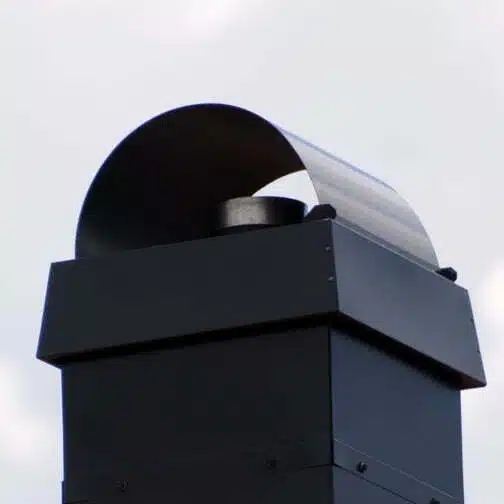chimney FAQ
Why Consider A Custom Chimney Solution
Short Answer: Custom chimney solutions enhance your home's aesthetic appeal, ensures optimized functionality, and boosts property value. It also allows for the integration of advanced safety features. This approach can turn your chimney into a masterpiece that meets your unique needs.

Chimneys play a crucial role in the safety and functionality of a home. Besides providing an escape route for smoke from a fireplace or stove, chimneys add aesthetic appeal and character to a house. But have you ever considered the benefits of a custom chimney solution?
Understanding Custom Chimney Solutions
When we talk about custom chimney solutions, we’re talking about more than just a one-size-fits-all approach to chimney design and installation. A custom chimney solution is an innovative approach to chimney design, where the chimney’s specifications are meticulously tailored to meet the unique needs of your home. It’s a comprehensive plan that considers your home’s specific requirements while encapsulating your aesthetic preferences and addressing functional aspects. Here, we’ll break down what a custom chimney solution entails.
Defining Custom Chimney Solutions
A custom chimney solution is essentially a bespoke chimney designed to fit your home’s individual architecture and heating system. It is an end-to-end solution that includes consultation, design, materials selection, construction, and ongoing maintenance, all tailored to your unique specifications.
The Elements of a Custom Chimney Solution
A custom chimney solution encompasses various elements, each tailored to your needs. Let’s explore these in detail:
- Design: A significant element of a custom chimney solution is the design. The design not only incorporates the chimney’s appearance but also its size, shape, and the placement within your home.
- Materials: The materials chosen will significantly influence your chimney’s durability, functionality, and visual appeal. Common materials include brick, stone, metal, or a combination of these.
- Safety Features: These can include elements like an optimized flue design for better draft and smoke evacuation, heat-resistant materials, and safety caps to prevent animal intrusion or embers escaping.
Tailoring to Your Needs
The real beauty of a custom chimney solution is how it is tailored to your specific needs. If you use your fireplace frequently, the chimney can be designed to handle that load efficiently. If you live in a region with harsh winters, the materials and design can be optimized for that. And if you desire a unique shape or finish to complement your home’s architecture, that too can be incorporated.
Reasons to Consider a Custom Chimney Solution
Chimneys are more than just functional components of a home – they are integral to the aesthetics, value, and safety of your property. Considering a custom chimney solution allows you to tailor this essential part of your home to your unique needs and desires. Let’s delve into the key reasons why a custom chimney solution is an option worth considering.
- Aesthetics: One of the main reasons homeowners opt for a custom chimney solution is for its aesthetic appeal. The chimney is a prominent part of your home’s exterior, and a custom design can enhance its overall look.
- Improved Functionality: A custom chimney solution is designed with your specific heating needs and house structure in mind. This means better draft, minimized smoke backflow, and optimum fireplace or stove performance.
- Increased Home Value: A beautifully designed, highly functional chimney can significantly boost your home’s resale value. A custom chimney isn’t just a functional element; it’s a statement feature that potential buyers are willing to pay a premium for.
- Enhanced Safety: Safety is paramount when it comes to chimneys. A custom chimney solution allows for enhanced safety measures, such as improved ventilation and superior fire resistance, to be integrated into the design.
The Custom Chimney Solution Process
Embarking on a custom chimney project is an exciting endeavor. Below is an in-depth look at the standard process, broken down into sequential steps.
- Initial Consultation: The first step in the process is to schedule a consultation with a professional chimney design and installation company. This session is where you get to share your vision, needs, and preferences.
- Site Survey: After the initial consultation, the professionals will conduct a thorough site survey. They will assess the current structure, location, and condition of your existing chimney (if any), along with other elements of your home’s structure and design.
- Design Phase: Once the necessary information has been collected, the design phase commences. Architects and designers will use the data gathered from the consultation and site survey to create a blueprint for your custom chimney.
- Cost and Timeline Estimation: After the design is finalized, the team will provide a detailed estimate of the costs and a timeline for completion. This breakdown includes costs for materials, labor, and any necessary permits or inspections.
- Construction and Installation: Once you approve the cost and timeline, the construction phase begins. Professionals will carefully follow the design blueprint, ensuring all safety standards and building regulations are met.
- Inspection and Commissioning: After the construction is completed, a thorough inspection will be conducted to ensure everything is built to code and that the chimney is safe for use.
- Maintenance Planning: The final step is establishing a maintenance plan. Regular maintenance is essential to ensure the longevity and safety of your chimney.
Conclusion
A custom chimney solution presents an opportunity to enhance your home’s aesthetic appeal, improve functionality, increase resale value, and ensure optimal safety. It’s a personalized approach to a vital part of your home. By working with a professional, you can create a solution that’s tailored to your specific needs and preferences.
